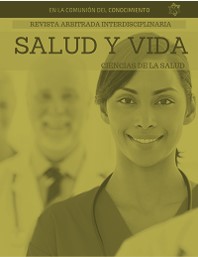Determination of the biological risk factor in domestic solid waste collection workers
DOI:
https://doi.org/10.35381/s.v.v6i2.2085Keywords:
Waste products, medical waste, industrial waste. (Source, DeCS).Abstract
Objective: To identify the biological risk factor presented by domestic solid waste collection workers of the Empresa Pública Municipal de Gestión Integral de Desechos Sólidos Ambato (EPM-GIDSA), Ecuador, in the year 2020. Method: Descriptive observational study. Results: the Risk Level in the population under study, it is observed that Influenza has a higher score 8. Conclusion: The BIOGAVAL method applied in collection workers of EPM GIDSA suggests that the biological risk factor, in the micro biological agents studied, is in Biological Action Levels (BAL), with a score higher than 8, therefore preventive measures should be used to reduce the level of risk, with emphasis on improving the aspects evaluated by the questionnaire of the hygienic measures of the method, and in the same way strengthen vaccination for agents in search of immunization.
Downloads
References
Fang-Huerta MÁ, Meléndez-Méndez MC, Garza-Hernández R, Aguilera-Pérez, P., Aguilera-Pérez, A., & Ortega-López, R. M. Percepción del personal de enfermería sobre los riesgos biológicos [Nursing staff perception of biohazards]. Rev CONAMED; 2015;20(1):12-16.
Díaz-Salvador J, De La Cruz-Ruiz M. Riesgo biológico del profesional de enfermería en el servicio de emergencia del Hospital Daniel Alcides Carrión Callao, Perú [Biological risk of the nursing professional in the emergency service of the Hospital Daniel Alcides Carrión Callao]. Revista Enfermería Herediana [Internet]. 9ago.2017 [citado 25oct.2022];10(1):54. Available from: https://revistas.upch.edu.pe/index.php/RENH/article/view/3132
Arenas-Sánchez A, Pinzón-Amaya A. Asociación entre los rasgos de personalidad y la ocurrencia de accidentes de trabajo de riesgo biológico del personal de enfermería en el Hospital Universitario de Santander (HUS): estudio de casos y controles [Biohazard in nursing staff: a practical review]. MedUNAB [Internet]. 2021;24(2):220-32. Disponible en: https://revistas.unab.edu.co/index.php/medunab/article/view/3981
Pérez-Díaz Y, Pedroso-Ramos L, Pérez-Santoya L. Evaluación del riesgo biológico en laboratorio clínico aplicando el método BIOGAVAL [Biological risk assessment in clinical laboratories using the BIOGAVAL method]. Medimay [Internet]. 2020; 27 (2):[aprox. 12 p.]. Disponible en: http://www.medimay.sld.cu/index.php/rcmh/article/view/1643
Encarnación R, Baquerizo J, Escobar K, Garcés D. Evaluación de los Niveles de Riesgo por Exposición a Agentes Biológicos en una Sala de Autopsia del Departamento Forense en la Ciudad de Machala-Ecuador [Evaluation of the Risk Levels of Exposure to Biological Agents in an Autopsy Room of the Forensic Department in the City of Machala-Ecuador]. CARÁCTER [Internet]. 2021;7(1). Disponible en: https://www.upacifico.revistasjournals.com/index.php/up/article/view/26
Contreras Velásquez Zaida Rocío, Ramirez Leal Pastor. Comparación de métodos utilizados en la valoracion del riesgo biológico [Comparison of methods used in biological risk assessment]. Rev Asoc Esp Espec Med Trab [Internet]. 2019; 28( 2): 91-108.
Coral K, Rodríguez MA, Oviedo JE. Riesgo biológico en el aire respirable de los minadores de basura en la Et2 Zámbiza en Quito-Ecuador [Biological risk in respirable air from garbage miners in Et2 Zámbiza in Quito-Ecuador]. Rev Ambydes [Internet]. 2018;21(41):79-92. Disponible en: https://revistas.javeriana.edu.co/index.php/ambienteydesarrollo/article/view/22194
Benavent Nácher, S., Machí Alapont, M., Moliner Sales, I., & Soto Ferrando, P. Evaluación de riesgo biológico en el Hospital Rey Don Jaime [Biological risk assessment at the Hospital Rey Don Jaime]. Medicina y Seguridad del Trabajo, 2007;53(206), 9-14.
Rodríguez M, Valdez M, Rayo M, Alarcón K. Riesgos biológicos en instituciones de salud [Biohazards in healthcare institutions]. Medwave Jul; 2009;9(7) doi: 10.5867/medwave.2009.07.4040
Padrón VY, Moreno PSN, Márquez FA, et al. Accidentalidad laboral en expuestos a riesgos biológicos en instituciones de salud [Occupational accidents in health institutions exposed to biohazards]. Rev Ciencias Médicas. 2017;21(2):202-209.
Instituto Valenciano de Seguridad y Salud en el Trabajo. Manual Práctico para la evaluación del Riesgo Biológico en actividades laborales diversas BIOGAVAL [Practical Manual for the evaluation of Biological Risk in various work activities BIOGAVAL]. [Internet], 2018. Disponible en: https://n9.cl/01kr8
Centeno Araya, M. G., Rodríguez Rojas, I. M., & Álvarez Fallas, J. P. Evaluación de riesgos biológicos en los trabajadores de la recolección de residuos sólidos urbanos ordinarios de las Municipalidades de Cañas y Tilarán [Evaluation of biological risks in workers of the municipalities of Cañas and Tilarán in the collection of ordinary urban solid waste]. 2018. [Internet].
https://hdl.handle.net/20.500.13077/158
Charca-Benavente, L. C., Huanca-Ruelas, G. H., & Moreno-Loaiza, O. Accidentes biológicos en estudiantes del último año de medicina de tres hospitales de Lima, Perú [Biological accidents in final year medical students of three hospitals in Lima, Peru]. Medwave, 2016;16(07).
Constans Aubert, A., Alonso Espadalé, R. M., & Pérez Nicolás, J. Utilización de los equipos de protección individual frente al riesgo biológico por el personal sanitario [Use of personal protective equipment against biological risk by healthcare personnel]. Medicina y Seguridad del Trabajo, 2008;54(210), 35-45.
Ramos Guacia, M. A., Pardo-Gómez G.E., Agüero-López, B. Evaluación de riesgo biológico en laboratorios de control de calidad del Instituto Finlay [Biological risk assessment in quality control laboratories of the Finlay Institute]. Vaccini Monitor, 2019;28(1), 29-37.
Published
How to Cite
Issue
Section
License
CC BY-NC-SA : Esta licencia permite a los reutilizadores distribuir, remezclar, adaptar y construir sobre el material en cualquier medio o formato solo con fines no comerciales, y solo siempre y cuando se dé la atribución al creador. Si remezcla, adapta o construye sobre el material, debe licenciar el material modificado bajo términos idénticos.
OAI-PMH: https://fundacionkoinonia.com.ve/ojs/index.php/saludyvida/oai.









